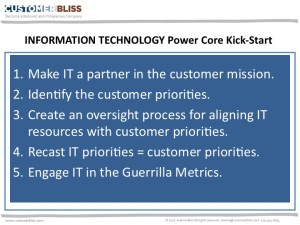Power Core Series – 5 of 6
When information technology (IT) is the power core, the ability to weave customer management into the organization is also a bit of a wild card based on leadership, its ability to bring the silos together, and the organizational appetite for delivering a unified platform to customers.
Areas of Strength
When IT is calling the shots for the business, investments are often allocated by jobs, projects and what can be executed by quarter. You have a clear idea of what you can expect to roll out each year. Metrics are specific to operational execution areas. With a strong IT power core, you could be fortunate to be far along on the continuum of collecting and using customer data and feedback. Strong IT departments push very hard for the business leaders to provide clear requirements for the application of resources. That means people must justify what they’re doing to get funding.
Customer Vulnerability and Hot Spots
The great vulnerability is the decision-making process to determine a priority. Most processes for getting IT funding aren’t comprehensive to the point of seeing how the pieces connect to form the business. They don’t begin to put the puzzle together for how it connects for customers. Therefore, what gets done in any given year may not amass to something greater for customers.
In this power core, as we have seen in others, there is no glue bringing the silos together to connect the operations. Each creates its own annual plan, IT requirements, and budget. The results can be exasperating for customers as they are automated within databases.
- How many different ways for sorting customers exist in your company?
- How many individual databases do you think have sprouted up to run the engines for each individual department?
Each one of them undoubtedly was argued for in a specific and intelligent way. The risk here is that now we’re not only delivering a disjointed experience to customers, we’ve automated it. I call it “automating mediocrity.”
A Kickstart for Integrating the Customer into the IT Power Core
1. Make information technology a partner in the customer mission.
2. Identify the customer priorities.
3. Create an oversight process for aligning IT resources with customer priorities.
4. Recast IT priorities = customer priorities.
5. Engage IT in the guerilla metrics.
This is about the planning process, about the silos working together, and about someone integrating the pieces
Trying to do this will feel like a putting together a Rubik’s cube. Some of the best partners I have had in companies were in IT. The onus was on me to make them a partner by bringing them to understand what we were trying to accomplish. But once they did, there was an amazing enthusiasm for this customer work. The reason is that the data and levers that IT can pull can have huge benefits to the customer experience and customer profitability. They crave business requirements that amalgamate up to results, something that are often sorely lacking according to them.
The first job is making IT a true partner in the customer experience mission. People make the mistake of bringing IT in too late in the game. You’ve got to define what you’re all about, and IT needs to be sitting at the table when this happens. You’ll see them become animated, involved and committed to the mission. They’ll begin to develop the intuition you need them to have as they become arbiters for deciding where the work falls on the priority list. As their role is elevated to custodian of the customer relationship, this power core becomes a powerhouse for driving the customer agenda.
Next, you’ve got to see ensure what has been prioritized adds up. There are a slew of projects in the queue that relate somehow to customers. Evaluate them to see how they all add up. You won’t be able to change anything for this year, but it will be a training ground for building next year’s plan. Using what you’ve learned, create the set of customer priorities that the company commits to. Focus on the few important things versus a mountain of small projects. Urge groups to work cross-functionally to create the plans for resource requirements, including IT. And don’t forget to have IT on those planning groups. Create the specific questions that the projects must meet to get slated a priority. Continue to review quarterly as you foster the advocacy and IT ownership of the customer thing.





